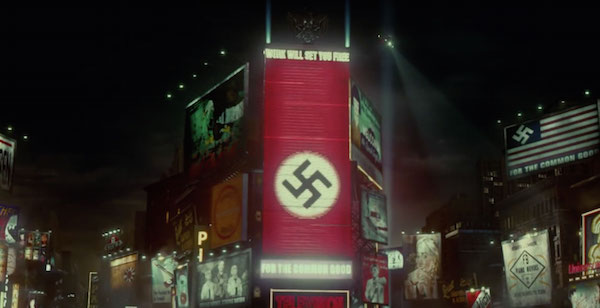Amazon's Nazi-Oriented Ads Have Been Pulled From New York Subway

The story continues to unravel as Amazon’s new series Man In The High Castle remains in hot water due to its advertisements. New York City residents have voiced their disapproval for the ads in MTA Subways, and definitive action has been taken in response. Due to outcry from New Yorkers, advertisements containing Nazi imagery have officially been removed from subway cars.
Controversy spurred after Nazi symbols adorned certain subway cars in order to promote Amazon’s new dystopian series. The Metropolitan Transportation Authority has taken quick action following subway riders disapproval, removing the advertisements which were originally going to be in place through mid December.
Rather than a traditional poster and advertising campaign in New York subway cars, the advertisements for The Man in the High Castle completely covered the inside of certain cars. This aggressive forced subway riders into sitting in seats covered in Nazi and Imperial Japanese imagery if they wanted to reach their destination. This form of marketing disallowed subway riders to ignore or look away from the ads, and transported them into the fictional universe that Blake created in his novel.
The Man In The High Castle is based off the 1962 novel of the same name. Written by late novelist Philip K Dick, the story takes place in an alternate America, illustrating a fictional reality where World War II was lost. Following the Axis victory, America is split between the Nazi Party and Imperial Japanese resulting in a totalitarian rule of the country. Amazon’s television adaptation premiered on November 20th, which was closely followed by the controversial ads.
Deadline has reported that Amazon stands by both The Man in the High Castle and the subway advertising campaign. The streaming service’s programming has prided itself on bringing controversy and wholly original material, such as the company's acclaimed family piece Transparent.
Regardless of whether or not one agrees with the campaign, what cannot be denied is the subway advertisements’ ability to get people talking. In a time where most subway riders keep their heads down and on their mobile devices, Amazon forced the riders to take a look at the imagery being used.
Additionally, this controversy has the possibility of starting a dialogue about marketing, and how cognizant all parties involved may have to be in the future. After all, the advertisements for The Man In High Castle surely had to be approved by a plethora of individuals, from both the MTA and Amazon side alike.
Your Daily Blend of Entertainment News
This is not the first time that television and movie advertisements have been banned, and surely won’t be the last. And while Amazon didn’t have the intention of offending the thousands of New Yorkers who ride the subway on a daily basis, it is clear that the ads have created a substantial buzz. The question is: Is there really no such thing as bad publicity? Only time will tell.

Corey was born and raised in New Jersey. Graduated with degrees theater and literature from Ramapo College of New Jersey. After working in administrative theater for a year in New York, he started as the Weekend Editor at CinemaBlend. He's since been able to work himself up to reviews, phoners, and press junkets-- and is now able to appear on camera with some of his favorite actors... just not as he would have predicted as a kid. He's particularly proud of covering horror franchises like Scream and Halloween, as well as movie musicals like West Side Story. Favorite interviews include Steven Spielberg, Spike Lee, Jamie Lee Curtis, and more.
